Consolidation Reference Manual
You can still refer to the Consolidation reference manual for consolidation information that has not been impacted by changes in the legislation.
C2 Assets
C2-2 High-level worked example
Cost setting on entry
C2-2-120 Consolidated group join another consolidated group
Description
This high-level example shows how a consolidated group joining another consolidated group (group to group) is treated like a single entity joining a consolidated group. It also illustrates one of the more complex group-to-group modifications to the basic case cost setting process, for over-depreciated assets (step D).
Commentary
When a consolidated group is acquired by another consolidated group the core rules provide that the head company of the acquired group is treated as a single entity joining the acquiring consolidated group → Subdivision 705-C, Income Tax Assessment Act 1997 (ITAA 1997). The subsidiary members of the acquired group are treated as parts of the head company of that group, and their assets (other than intragroup membership interests) as assets of that head company. This is achieved by way of modifications to the basic case. → section 705-185, ITAA 1997
One of the more complex modifications to the basic rules relates to the adjustment for over-depreciation of assets in joining entities (step D of the cost setting process). This ensures that the tax cost setting amount is not inappropriately reduced for over-depreciated assets brought into the acquired group by an entity on joining. There is no reduction for over-depreciation to the extent that rebatable dividends paid out of profits sheltered from tax by the over-depreciation have not left the acquired group. → section 705-190, ITAA 1997
There is no modification where an over-depreciated asset was, just before the acquired group's time of consolidation, held by the head company of that group, and is still over-depreciated at the time the acquired group becomes part of the acquiring group. This is because section 705-50 of the ITAA 1997 applies appropriately to such assets.
Note, however, that the over-depreciation provisions in the tax cost setting rules have been modified for an entity that becomes a member of a consolidated group between 9 May 2007 and 30 June 2009. In this case the head company will only need to look at five years of dividend history immediately before the joining time to determine whether an over-depreciation adjustment is required in relation to the joining entity's asset. Effective from 1 July 2009, the over-depreciation adjustment in section 705-50 has been repealed so it will no longer apply to over-depreciated assets of entities that become subsidiary members of a consolidated group on or after that date. → Tax Laws Amendment (2010 Measures No.1) Act 2010 (No.56 of 2010)
Example
Facts

On 1 July 2000, HC1 and JE are incorporated, with JE as a wholly-owned subsidiary of HC1. HC2 owns 60% of the shares in HC1. Mr X (an unrelated 3rd party) owns the other 40% of shares. Just after incorporation on 1 July 2000 the companies' financial positions are as follows:
| Cash | 200 | Equity | 800 |
| Asset 1 (MV 200, AV 200) | 200 | ||
| Shares in JE (MV 400) | 400 | ||
| 800 | 800 |
| Asset 2 (MV 400, AV 400) | 400 | Equity | 400 |
| 400 | 400 |
During the first year, HC1 makes a net profit after tax of $53. Of this an amount of $20 is sheltered from income tax due to over-depreciation. No provision is made for any future tax liability. HC1's taxable income is $50. Its financial position is as shown in table 3.
| Cash | 290 | Equity | 800 |
| Asset 1 (MV 180, AV 160) | 180 | Provision for dividend | 53 |
| Shares in JE (MV 780) | 400 | Provision for income tax | 17 |
| 870 | 870 |
After a year of trading, JE makes a net profit after tax of $364. Of this an amount of $100 is sheltered from income tax due to over-depreciation. JE's taxable income is $400. No provision is made for future tax liability. JE's financial position is as follows:
| Cash | 600 | Equity | 400 |
| Asset 2 (MV 300, AV 200) | 300 | Provision for dividend | 364 |
| Provision for income tax | 136 | ||
| 900 | 900 |
During the year ending 30 June 2002, HC1 pays all of its profits for the previous year ($53) as a dividend to its shareholders. The dividend consists of a franked component of $40 and $13 paid as an unfranked dividend that relates solely to profits sheltered from tax due to over-depreciation. HC2 retains the unfranked portion of the dividend it receives. HC1's financial position at 30 June 2002 is as follows:
| Cash | 684 | Equity | 800 |
| Asset 1 (MV 160, AV 120) | 160 | Accumulated profits | 426 |
| Shares in JE (MV 640) | 400 | Provision for income tax | 18 |
| 1,244 | 1,244 |
During the year ending 30 June 2002, JE pays all of its profits for the previous year ($364) as a dividend to HC1. The dividend consists of a franked component of $317 and $47 paid as an unfranked rebatable dividend that relates solely to profits sheltered from tax due to over-depreciation. HC1 retains this dividend. JE's financial position at 30 June 2002 is as follows:
| Cash | 500 | Equity | 400 |
| Asset 2 (MV 200, AV 0) | 200 | Profit after income tax | 240 |
| Provision for income tax | 60 | ||
| 700 | 700 |
HC1 and JE form a consolidated group
HC1 forms a consolidated group with JE on 1 July 2002. The group's financial position is unchanged from 30 June 2002. JE held an over-depreciated asset with a market value (MV) of $200 but a nil adjustable value (AV) at the formation time.
When a consolidated group forms, the tax costs of assets owned by the head company are not set. However, the tax costs of assets of subsidiaries are set under the asset cost setting rules, unless the head company is eligible to choose to retain existing tax costs and chooses to do so. HC1 chooses not to retain existing tax costs for JE, and the tax cost setting rules will apply.
HC1 begins by calculating the entry allocable cost amount (ACA) for JE as shown in the following section.
Calculation - setting the tax costs of JE's assets
A: Calculate entry ACA for JE
ACA step 1: Add up the cost of each membership interest
HC1 owns 100% of membership interests in JE from the date of incorporation to date of formation. JE is incorporated for $400 on 1 July 2000, and the market value of HC1's interests at 1 July 2002 is $640 (Interest 1 in the following worksheet). There are no outstanding cost base adjustments for membership interests, such as for earlier value shifting or loss transfers.
→ subsection 705-65(3), ITAA 1997; and Explanatory Memorandum to New Tax System (Consolidation) Bill (No.1) 2002, paragraph 5.60
Worksheet: Step 1 - Add up the cost of each membership interest

ACA step 2: Add liabilities of the joining entity at the joining time
The provision for income tax is shown as Liability 1. No reductions or adjustments are required. There are no employee shares, no non-membership equity interests issued by JE and no debt interests that are regarded as equity for general accounting purposes.
Worksheet: Step 2 - Add liabilities etc

ACA step 3: Add undistributed profits which accrued to the group
As HC1 elects to consolidate from 1 July 2002, in the first year of the two-year transitional period, and JE is a wholly-owned subsidiary on that date, the transitional rule for ACA step 3 applies → former section 701-30, Income Tax (Transitional Provisions) Act 1997 (IT(TP)A 1997). All undistributed profits accrued to the group are included.
JE has a total of $240 in undistributed profits that would accrue to HC1, of which $100 is unfranked and relates solely to profits sheltered from income tax due to over-depreciation. The balance relates to trading profit that is fully frankable and for which a provision of income tax of $60 is recognised in the accounts.
Worksheet: Step 3 - Add undistributed profits accrued to the group
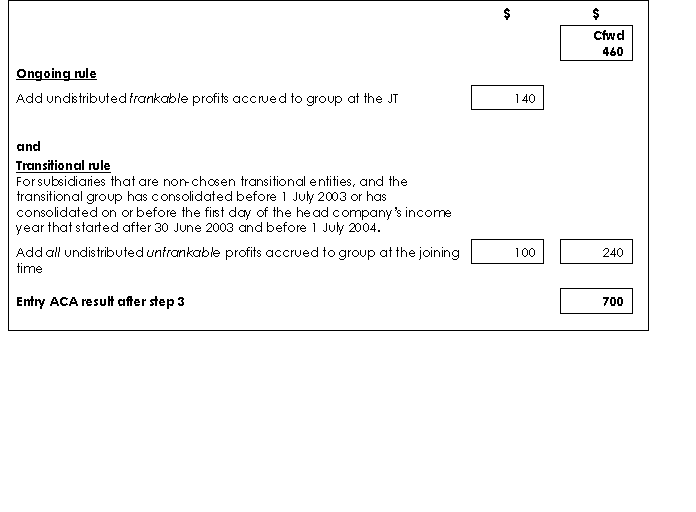
ACA steps 3A, 4, 5, 6 and 7
Steps 3A, 4, 5, 6 and 7 do not apply.
ACA Step 8
The ACA is $700.
B : Subtract value of JE's retained cost base assets
The ACA amount ($700) less retained cost base assets ($500) results in an ACA balance of $200.
C : Apportion remainder of ACA over remaining assets other than excluded assets
The remainder of the ACA of $200 is to be allocated to the reset cost base asset (Asset 2). However, a further reduction of this amount may be required if the asset is over-depreciated.
D : Adjust the amount for over-depreciated assets
Is the asset over-depreciated?
Worksheet: Is Asset 2 over-depreciated?
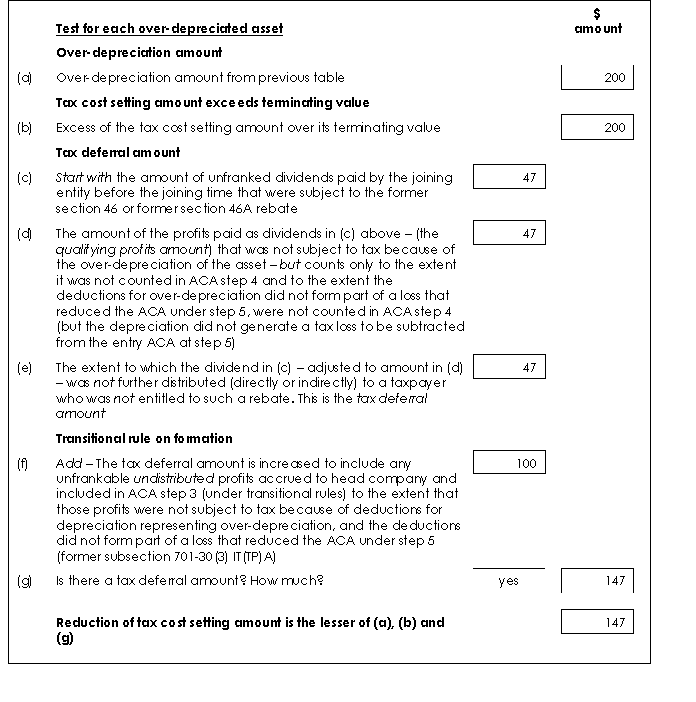
The market value of $200 exceeds the adjustable value of $0 by $200. The cost of $400 exceeds the adjustable value of $0 by $400. Under both tests for over-depreciation, Asset 2 is over-depreciated.
The tax cost setting amount for an over-depreciated asset is reduced by the lesser of the over-depreciation amount (calculated above), the excess of the tax cost setting amount over its terminating value, and the tax deferral amount (calculated in the following worksheet).
Worksheet: Asset 2 - over-depreciation reduction
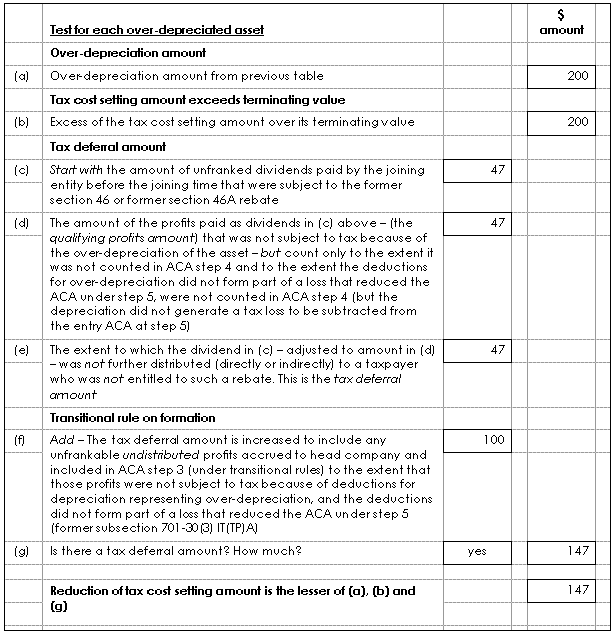
The tax cost setting amount for Asset 2 of $200 must be further reduced by $147 to $53.
Further facts
On consolidation, HC1 and JE enter into a tax sharing agreement. JE agrees to pay to HC1 an annual amount based on an estimate of the tax that would have been payable had JE continued to be liable for tax on its income after deductions.
The financial positions of HC1 and JE at 30 June 2003 are as shown in tables 7 and 8.
| Cash | 766 | Equity | 800 |
| Tax sharing agreement right | 102 | Accumulated profits | 488 |
| Asset 1 (MV 140, AV 80) | 140 | Provision for income tax | 120 |
| Shares in JE (MV 831) | 400 | ||
| 1,408 | 1,408 |
| Cash | 833 | Equity | 400 |
| Asset 2 (MV 100, AV 0) | 100 | Accumulated profits | 431 |
| Provision for tax sharing | 102 | ||
| 933 | 933 |
Group consisting of HC1 and JE is acquired by another consolidated group
HC2 is the head company of an existing consolidated group consisting of itself and A and B (see figure 1). On 1 July 2003, HC2 acquires the remaining 40% of shares from Mr X for $687.60. HC1 is now ineligible to be a head company of a consolidated group as it is now a wholly-owned subsidiary of another company eligible to be a head company. Both HC1 and JE become members of HC2's consolidated group.
However, the cost setting rules are modified to operate as if only the head company of the acquired group joins, and all assets of the acquired group are treated as assets of the old head company for the purpose of setting tax costs of assets. → section 705-185, ITAA 1997
HC2 begins by calculating the entry ACA for HC1 as shown in the following section.
Calculation - setting tax costs of HC1's assets (and those of its member parts as a single entity)
A: Calculate entry ACA for HC1
ACA step 1 : Add up the cost of each membership interest
HC2 acquired 60% of membership interests in HC1 on 1 July 2000 when it was incorporated, for an amount of $480 (Interest 1 in the worksheet below). This membership interest has a market value of $1,031 on 1 July 2003. HC2 acquires the remaining 40% on 1 July 2003 for $687.60 (Interest 2 in the worksheet below rounded to $688). There are no outstanding cost base adjustments for membership interests, such as for earlier value shifting or loss transfers.
Worksheet: Step 1 - Add up the cost of each membership interest

ACA step 2 : Add liabilities of the joining entity at the joining time
The provision for income tax is shown as Liability 1. No reductions or adjustments are required. There are no employee shares, no non-membership equity interests issued by HC1 or JE and no debt interests that are regarded as equity for general accounting purposes.
Worksheet: Step 2 - Add liabilities etc.
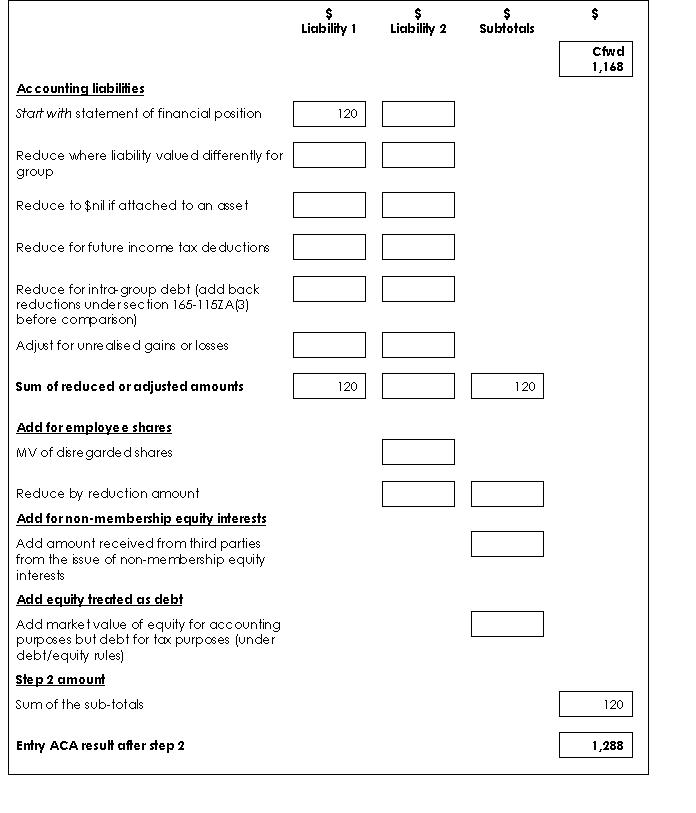
ACA step 3: Add undistributed profits which accrued to the group
From HC1's franking account, it can be seen that, as at 30 June 2003, $499 is franked and a further $280 would be frankable (provision for income tax $120). (Subsections 705-90(3) and (4) require that a hypothetical adjustment be made to the franking account on the basis that the tax would have been paid by 30 June 2003.) Therefore, HC1's undistributable, frankable profits at the joining time would be $779, of which only $467 (rounded) would accrue to the acquiring group, as HC2 only held 60% interest in HC1 continuously until 1 July 2003.
Worksheet: Step 3 - Add undistributed profits accrued to the group
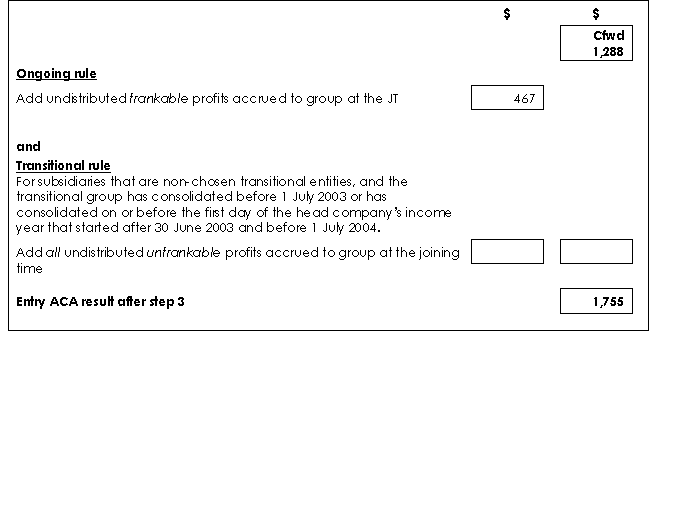
ACA steps 3A, 4, 5, 6 and 7
Steps 3A, 4, 5, 6 and 7 do not apply.
ACA Step 8
The ACA is $1,755.
B : Subtract value of JE's retained cost base assets
The ACA amount ($1,755) less the retained cost base asset (Cash $1,599 - i.e. $766 for HC1 and $833 for JE) results in an ACA balance of $156.
C : Apportion remainder of ACA over remaining assets other than excluded assets
The remainder ($156) is then apportioned amongst the reset cost base assets according to their market values. (The intragroup arrangement for tax sharing is ignored as the group is treated as a single taxpayer.)
| Reset cost base assets | Terminating value (TV) ) | Market value (MV) ) | Apportionment of remainder | Assets held on revenue account - excess over greater of TV or MV | Tax cost setting amount for asset |
| Asset 1 | 80 | 140 | 91 | 0 | 91 |
| Asset 2 | 0 | 100 | 65 | 0 | 65 |
| Totals | 80 | 240 | 156 | 0 | 156 |
There is no reduction to the tax cost setting amounts under section 705-40 for assets held on revenue account as the amounts do not exceed the greater of the assets' MV or TV.
D : Adjust the amount for over-depreciated assets
The tax cost setting amount for depreciation assets may be further reduced for over-depreciation. Note that no reduction occurred for Asset 1 when HC1 consolidated its group, as the tax costs of HC1's assets were not reset. The tax cost of Asset 2 was reduced when the first group formed; however, now that its tax cost has been reset, it needs to be tested again. → section 705-190, ITAA 1997
Is Asset 1 over-depreciated?
Worksheet: Is Asset 1 over-depreciated?

The market value of $140 exceeds the adjustable value of $80 by $60. The cost of $200 exceeds the adjustable value of $80 by $120. Under both tests for over-depreciation, asset 1 is over-depreciated.
The tax cost setting amount for an over-depreciated asset is reduced by the lesser of the over-depreciation amount (calculated above), the excess of the tax cost setting amount over its terminating value, and the tax deferral amount (calculated in the following worksheet).
Worksheet: Asset 1 - over-depreciation reduction
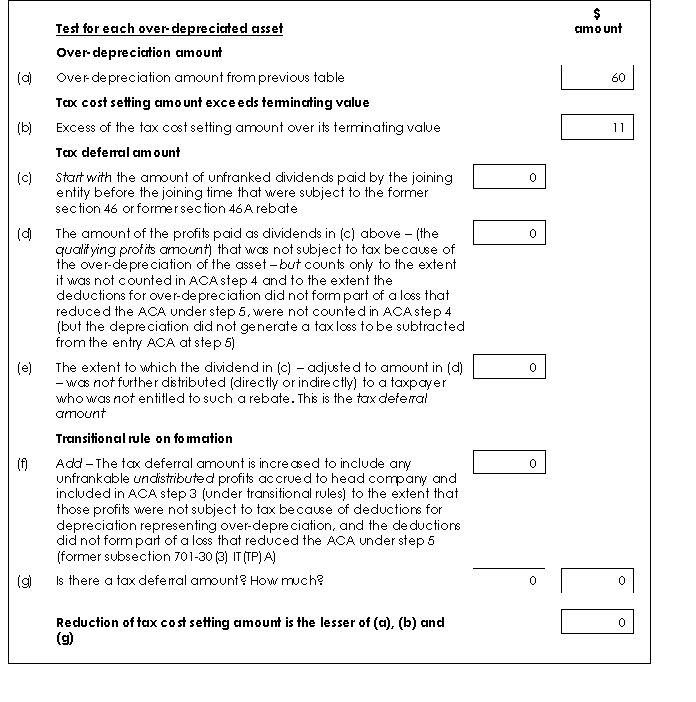
Asset 1's tax cost setting amount of $91 is accordingly not reduced.
Is Asset 2 over-depreciated?
Worksheet: Is Asset 2 over-depreciated?

The market value of $100 exceeds the adjustable value of $0 by $100. The cost of $400 exceeds the adjustable value of $0 by $400. Under both tests for over-depreciation, asset 2 is over-depreciated.
The tax cost setting amount for an over-depreciated asset is reduced by the lesser of the over-depreciation amount (calculated above), the excess of the tax cost setting amount over its terminating value, and the tax deferral amount (calculated in the following worksheet).
Worksheet: Asset 2 - over-depreciation reduction
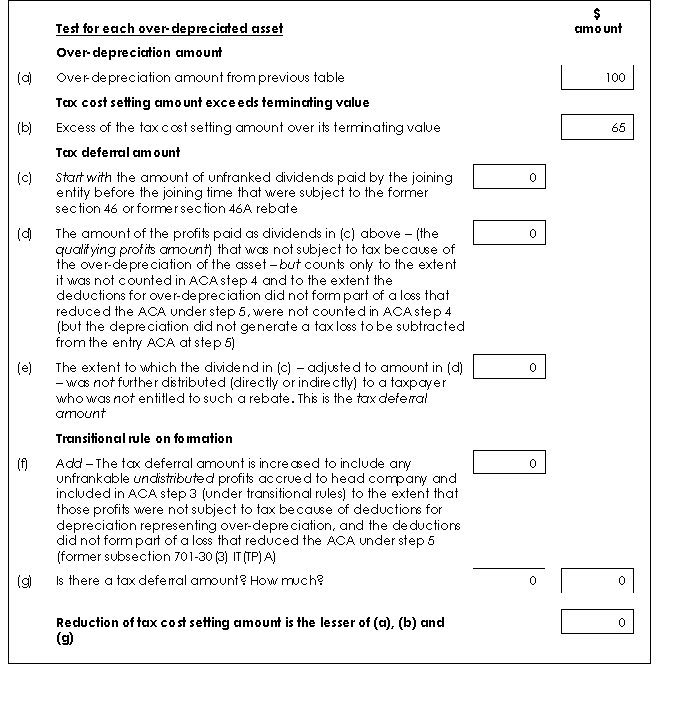
Asset 2's tax cost setting amount of $65 is accordingly not reduced.
Income tax calculations for HC1
| Year ended 30 June | Cost | Adjustable value at beginning | Method | Remainder of effective life in years | Tax deduction | Adjustable value at year end |
|---|---|---|---|---|---|---|
| 2001 | 200 | 200 | prime cost | 5 | 40 | 160 |
| 2002 | - | 160 | prime cost | 4 | 40 | 120 |
| 2003 | - | 120 | prime cost | 3 | 40 | 80 |
| Total | 200 | 120 |
Income tax payable by HC1
| Assessable income | 100 | |
| Allowable deductions | ||
| Expenses | 10 | |
| Depreciation of Asset 1 | 40 | 50 |
| Taxable income | 50 |
Tax payable $17 ($50 x 34%)
| Assessable income | 120 | |
| Dividend received | 364 | 484 |
| Allowable deductions | ||
| Expenses | 20 | |
| Depreciation of Asset 2 | 40 | 60 |
| Taxable income | 424 |
Tax on taxable income $127 (424 x 30%) less dividend rebate $109 (364 x 30%)
Tax payable $18
| Assessable income (group income) | ||
| HC1 | 120 | |
| JE | 1,000 | 1,120 |
| Allowable deductions | ||
| Expenses of HC1 | 20 | |
| of JE | 607 | |
| Depreciation: of Asset 1 | 40 | |
| of Asset 2 (AV 0) | 53 | 720 |
| Taxable income | 400 | |
Tax payable $120 ($400 x 30%)
| DR Tax sharing agreement right | 102 | |
| DR Income tax expense | 18 | |
| CR Provision for tax | 120 |
| Debit | Credit | Balance | ||
|---|---|---|---|---|
| $ | $ | $ | ||
| 1 July 2000 | Opening balance | 0 | ||
| 30 June 2001 | Closing balance | 0 | ||
| 1 July 2001 | Opening balance | 0 | ||
| 31 Aug 2001 | Payment of tax for 2000-01
(tax 17 x 70/30) |
40 | 40 CR | |
| 30 Sept 2001 | Payment of dividend | 40 | 0 | |
| 31 Oct 2001 | Receipt of franked dividend | 317 | 317 CR | |
| 30 June 2002 | Closing balance | 317 CR | ||
| 1 July 2002 | Opening balance | 317 CR | ||
| 31 Aug 2002 | Payment by HC1 of tax for 2001-02 (18 x 70/30) | 42 | 359 CR | |
| 31 Aug 2002 | Payment by JE of tax for 2001-02 (60 x 70/30) | 140 | 499 CR | |
| 30 June 2003 | Closing balance | 499 CR | ||
| 30 June 2003 | Actual balance | 499 CR | ||
| 30 June 2003 | Hypothetical payment by 30.6.03 of tax for group for 2002-03 (120 x 70/30) | 280 | 779 CR | |
| 30 June 2003 | Hypothetical closing balance | 779 CR |
Income tax calculations for JE
| Year ended 30 June | Cost | Adjustable value at beginning | Method | Remainder of effective life in years | Tax deduction | Adjustable value at year end |
|---|---|---|---|---|---|---|
| 2001 | 400 | 400 | prime cost | 2 | 200 | 200 |
| 2002 | - | 200 | prime cost | 1 | 200 | 0 |
| 2003 | 53* | 0 | prime cost | 0 | 53 | 0 |
| Total | 400 | 453 |
Income tax payable by JE
| Assessable income | 1,000 | |
| Allowable deductions | ||
| Expenses | 400 | |
| Depreciation of Asset 2 | 200 | 600 |
| Taxable income | 400 |
Tax payable $136 ($400 x 34%)
| Assessable income | 1,100 | |
| Allowable deductions | ||
| Expenses | 700 | |
| Depreciation of Asset 2 | 200 | 900 |
| Taxable income | 200 |
Tax payable $60 ($200 x 30%)
| Notional assessable income | 1,000 | |
| Notional allowable deductions | ||
| Expenses | 607 | |
| Depreciation of Asset 2 | 53 | 660 |
| Notional taxable income | 340 |
Notional tax payable $102 ($340 x 30%)
| Debit | Credit | Balance | ||
|---|---|---|---|---|
| $ | $ | $ | ||
| 1 July 2000 | Opening balance | 0 | ||
| 30 June 2001 | Closing balance | 0 | ||
| 1 July 2001 | Opening balance | 0 | ||
| 31 Aug 2001 | Payment of tax for 2000-01
(tax 136 x 70/30) |
317 | 317 CR | |
| 31 Oct 2001 | Payment of franked dividend | 317 | 0 | |
| 30 June 2002 | Closing balance (actual) | 0 | ||
| 30 June 2002 | Closing balance (actual) | 0 | ||
| 30 June 2002 | Hypothetical payment by 30/6/02 of tax for 2001-02 (60 x 70/30) | 140 | 140 CR | |
| 30 June 2002 | Hypothetical closing balance | 140 CR | ||
References
Income Tax Assessment Act 1997 , section 705-50 and subsection 705-65(3) ; as amended by
- •
- New Business Tax System (Consolidation) Act (No. 1) 2002 (No. 68 of 2002), Schedule 1
- •
- New Business Tax System (Consolidation, Value Shifting, Demergers and Other Measures) Act 2002 (No. 90 of 2002), Schedule 2
Explanatory Memorandum to New Tax System (Consolidation) Bill (No.1) 2002, paragraph 5.60
Income Tax Assessment Act 1997 , Subdivision 705-C ; as amended by New Business Tax System (Consolidation and Other Measures) Act (No. 1) 2002 (No. 117 of 2002), Schedule 4
Income Tax (Transitional Provisions) Act 1997 , former section 701-30 ; as amended by:
- •
- New Business Tax System (Consolidation, Value Shifting, Demergers and Other Measures) Act 2002 (No. 90 of 2002), Schedule 7
- •
- New Business Tax System (Consolidation and Other Measures) Act (No. 1) 2002 (No. 117 of 2002), Schedule 5
Income Tax Assessment Act 1997 , former subsection 701-30 of the IT(TP)A 1997, as amended by Tax Laws Amendment (2010 Measures No.1) Act 2010 (No.56 of 2010), Schedule 5, Part 15
Income Tax Assessment Act 1997 , subsection 705-90(6) as substituted by Tax Laws Amendment (2004 Measures No. 7) Act 2005 (No. 41 of 2005), Schedule 6, Part 3
Explanatory Memorandum to Tax Laws Amendment (2004 Measures No. 7) Bill 2004, paragraphs 6.24 - 6.29
Income Tax Assessment Act 1997 , section 705-50 and subsection 995-1(1) as amended by Tax Laws Amendment (2010 Measures No. 1) Act 2010 (No. 56 of 2010), Schedule 5, Part 6
Income Tax Assessment Act 1997 , subsection 705-70(1) ; as amended by Tax Laws Amendment (2010 Measures No. 1) Act 2010 (No. 56 of 2010), Schedule 5, Part 8
Income Tax Assessment Act 1997 , subsection 705-85(3) ; as amended by Tax Laws Amendment (2010 Measures No. 1) Act 2010 (No. 56 of 2010), Schedule 5, Part 20
Explanatory Memorandum to Tax Laws Amendment (2010 Measures No. 1) Bill 2010, Chapter 5
Tax Laws Amendment (Repeal of Inoperative Provisions) Act 2006 (No. 101 of 2006), which repealed:
- •
- section 701-30 of the Income Tax (Transitional Provisions) Act 1997 , and
- •
- sections 46 , 46A and 160ZK of the Income Tax Assessment Act 1936
History
Revision History
Section C2-2-120 first published 2 December 2002 and updated 28 May 2003.
Further revisions are described below.
| Date | Amendment | Reason |
|---|---|---|
| 26.10.05 | Changes to worksheets pp.7 and 13, and references. | Legislative amendments |
| Changes to worksheet p. 17 | To correct error. | |
| 15.11.06 | Updated references to inoperative provisions. | Legislative amendment. |
| 22.6.07 | Note on proposed changes to clarify both the valuation of liabilities and the accounting principles to be used, and to the cost setting rules to phase out over-depreciation deductions, p. 21. | Reflect announcement on 8 May 2007 by Assistant Treasurer in media release no. 50. |
| 6.5.11 | References to non-membership equity interests.
Minor changes to reflect changed wording in 705-70(1). Removal of note regarding proposed changes to clarify both the valuation of liabilities and the accounting principles to be used, and to the cost setting rules to phase out over-depreciation deductions. Minor changes to reflect changed wording in 705-50. Revisions to reflect changes to the transitional concession for substituted accounting periods made to former subsection 701-30(1) of the IT(TP)A 1997. |
Legislative amendments. |
Current at 6 May 2011
